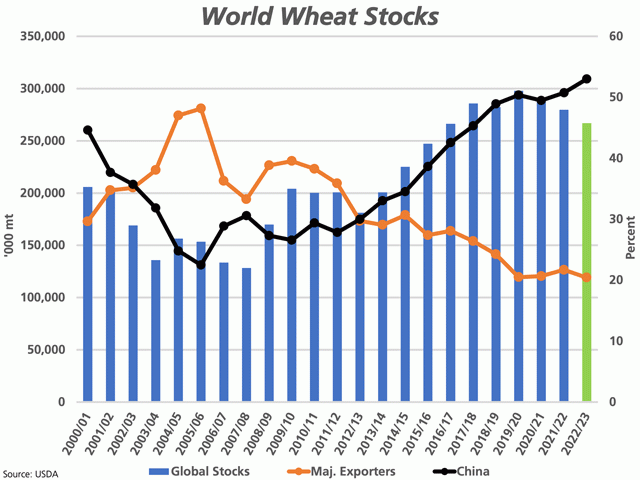Canada Markets
USDA's Global Wheat Forecast: A Closer Look at WASDE Report
A fire was lit under the wheat market on Thursday following the USDA's May World Agricultural Supply and Demand Estimates (WASDE) release, which included a first look at 2022-23 estimates. Of course, there is an incredible amount of uncertainty, which includes weather, specifically North America and western Europe, Ukraine's ability to harvest and export and the ability for Russia and India grow exports.
The USDA points to global production of wheat falling for the first time in four years, while by a mere 0.6% from the record reached in 2021-22, to 775 million metric tons (mmt). Domestic consumption is also forecast to fall for the first time in four years, while consumption is forecast to outstrip production for a second straight year and by an estimated 9.063 mmt (USDA FAS data), the largest spread in volume seen in 10 years. Global feed use is forecast to fall by 7.5 mmt year-over year, while total disappearance is forecast to fall by 3.27 mmt as human consumption use increases, which speaks to the price elasticity of wheat overall.
Exports of wheat are forecast to reach a record high of 204.89 mmt, up 5 mmt from 2021-22, creating growing pressure on the world's major exporters at a time when many are facing challenges of their own. Of the eight major exporters, the current forecast points to Canada growing exports by 8.5 mmt year over year as the country's production rebounds from the 2021 drought. This the largest of any year-over-year increase seen across the eight major shippers, with four of the eight exporters poised to grow exports from 2021-22 to 2022-23.
P[L1] D[0x0] M[300x250] OOP[F] ADUNIT[] T[]
The USDA's forecast shows Ukraine's exports falling from 19 mmt in 2021-22 to 10 mmt in 2022-23. Also of interest is the USDA's forecast that shows India increasing exports in 2022-23, from 8.15 mmt to 8.5 mmt. This is despite current concerns that a heatwave has robbed the country's production potential, which has some analysts calling for a return to imports in 2022-23.
As seen by the bars on the attached chart, global ending stocks of wheat are to fall by 12.7 mmt in 2022-23 to 267 mmt (green bar). This is a third consecutive drop in stocks and represents a larger drop than expected, with the average of pre-report estimates pointing to global stocks of 271.6 mmt. If realized, this would be the largest year-over-year drop in global stocks seen in 10 years.
According to USDA FAS data, stocks in the hands of the eight largest exporters are to fall for a fifth consecutive year to 54.494 mmt. While world demand remains robust, the share of global stocks held by the largest eight exporters is forecast to fall to 20.4% of the world total at the end of the 2022-23 crop year, after holding close to 50% of global stocks as recent as 2005-06. This is shown by the brown line on the attached chart, which shows this percentage falling in conjunction with global stocks, supportive for prices.
The black line shows how China's share of global stocks continues to trend higher, estimated at 53% in current data. While there is skepticism over the existence and quality of these stocks, one thing is certain is that they are not accessible to help meet global demand.
The USDA's forecast for Canada shows 33 mmt of production and 24 mmt of exports for 2022-23, higher than Canada's current government estimates which will be updated in May to incorporate the latest seeding intention data. Despite the surge in production expected, stocks are to grow by a modest 500,000 mt, to 3.42 mmt or 10.3% of forecast disappearance. This is 1.3 mmt lower than the current carryout forecast by Agriculture and Agri-Food Canada, signaling favorable demand prospects expected ahead.
Cliff Jamieson can be reached at cliff.jamieson@dtn.com
Follow him on Twitter @Cliff Jamieson
(c) Copyright 2022 DTN, LLC. All rights reserved.






Comments
To comment, please Log In or Join our Community .